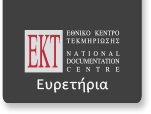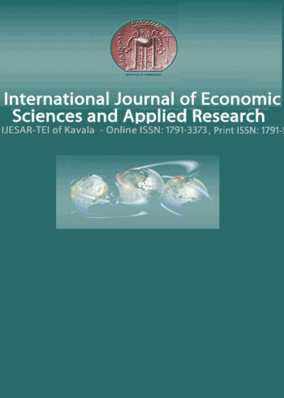Drivers of change in management accounting practices in an ERP environment
Part of : International journal of economic sciences and applied research ; Vol.6, No.2, (September), pages 149-174
Issue:
Pages:
149-174
Author:
Abstract:
This study contributes to contemporary research on changes in management accounting
(MA) practices by examining the effect of changes in data quality, information quality and
management accountants’ tasks on accounting efficiency and effectiveness, and indirectly on management accounting change after the implementation of an Enterprise Resource Planning
(ERP) system. Data was collected through an online survey questionnaire distributed to Finnish companies. Overall, the results of the PLS tests (n=70) provide significant support for the proposed model. Consistent with previous studies, time since ERP adoption appears to be a significant determinant of MA change, but the findings of this study also suggest that late adopters, that is, firms adopting an ERP system more recently, perceive greater changes in MA than early adopters. Further, the results indicate that global ERP implementations and use of business intelligence (BI) tools significantly relate to changes in MA practices. The implications
of these results for practice and future research are discussed.
Subject:
Subject (LC):
Keywords:
management accounting, ERP, BI, change, survey
Notes:
JEL Classification: M10, M15, M40
References (1):
- Adam, F. and O’Doherty, P., 2003, ‘ERP projects: good or bad for SME’s?’, Shanks, G., Seddon, P. and Willcocks, L., (eds.), Second-wave enterprise resource planning: Implementing for effectiveness, Cambridge University Press, Cambridge, pp. 275-298. Arnold, V. and Sutton, S.G., 1998, ‘The theory of technology dominance: Understanding the impact of intelligent decision aids on decision makers’ judgments’, Advances in Accounting Behavioral Research, 1, pp. 175-194. Ballou, D. and Pazer, H., 1985, ‘Modeling data and process quality in multi-input, multioutput information systems’, Management Science, 31, 2, pp. 150-162. Barclay, D., Higgins, C. and Thompson, R., 1995, ‘The Partial Least Squares (PLS) approach to causal modeling: Personal computer adoption and use as an illustration’, Technology Studies, 2, 2, pp. 285-324. Bernroider, E.W.N., 2008, ‘IT governance for enterprise resource planning supported by the DeLone–McLean model of information systems success’, Information & Management, 48, 5, pp. 257-269. Booth, P., Matolcsy, Z. and Wieder, B., 2000, ‘The Impacts of Enterprise Resource Planning Systems on Accounting Practice: The Australian Experience’, Australian Accounting Review, 10, 22, pp. 4-18. Bradley, R.V., Pridmore, J.L. and Byrd, T.A., 2006, ‘Information systems success in the context of different corporate cultural types: An empirical investigation’, Journal of Management Information Systems, 23, pp. 267-294. Burns, M., 2005, ‘Business intelligence survey’, CA Magazine, 138, 5, p. 18. Chin, W. W., 1998, ‘The partial least squares approach to structural equation modelling’, Marcoulides, G.A. (eds), Modern Methods for Business Research, Lawrence Erlbaum, Mahwah, NJ, pp. 295-336. Chou, D.C., Tripuramallu, H.B. and Chou, A.Y., 2005, ‘BI and ERP integration’, Information Management and Computer Security, 13, 5, pp. 340-349. Cooper, R. and Kaplan, R. S., 1998, ‘The promise - and peril - of integrated cost systems’, Harvard Business Review, July-August, pp. 109-119. Davenport T.H., 1998, ‘Putting the Enterprise into the Enterprise System’, Harvard Business Review, July-August, pp. 121-131. Davenport, T. H., 2010, ‘Business Intelligence and Organizational Decisions’, International Journal of Business Intelligence Research, 1, 1, pp. 1-12. Dechow, N. and Mouritsen, J., 2005, ‘Enterprise resource planning systems, management control and the quest for integration’, Accounting, Organizations and Society, 30, 7-8, pp. 691-733. DeLone, W. H. and McLean, E. R., 1992, ‘Information systems success: The quest for the dependent variable’, Information Systems Research, 3, 1, pp. 60-95. DeLone, W.H. and McLean, E.R., 2003, ‘The DeLone and McLean Model of Information Systems Success: A ten-year update’, Journal of Management Information Systems, 19, 4, pp. 9-30. Dillman, D. A., 2000, Mail and Internet Surveys: The Tailored Design Method, John Wiley, New York. Drury, C. and Tayles, M., 1995, ‘Issues arising from surveys of management accounting practice’, Management Accounting Research, 6, pp. 267-280. Elbashir, M.Z., Collier, P.A. and Davern, M.J., 2008, ‘Measuring the effects of business intelligence systems: The relationship between business process and organizational performance’, International Journal of Accounting Information Systems, 9, 3, pp. 135- 153. European Commission, 2011, ‘Small and medium-sized enterprises (SMEs) SME Definition’, Available at: http://ec.europa.eu/enterprise/policies/sme/facts-figuresanalysis/ sme-definition/index_en.htm (Accessed 24.07.2011). Evermann, J. and Tate, M., 2009, ‘Constructs in the mist: The lost world of the IT artifact’, Proceedings of the International Conference on Information Systems (ICIS), Phoenix, Arizona. Fahy, M.J. and Lynch, R., 1999, ‘Enterprise resource planning (ERP) systems and strategic management accounting’. Proceedings of the 22nd Annual congress of the European Accounting Association, Bordeaux, France. Fornell, C. and Larcker, D. F., 1981, ‘Evaluating Structural Equation Models with Unobservable Variables and Measurement Error’, Journal of Marketing Research, 18, 1, pp. 39-50. Geisser, S., 1974, ‘A predictive approach to the random effect model’, Biometrika, 61, pp. 101-107. Gorla, N. Somers, T.M. and Wong, B., 2010, ‘Organizational impact of system quality, information quality, and service quality’, Journal of Strategic Information Systems, 19, pp. 207-228. Grabski, S. and Leech, S., 2007, ‘Complementary controls and ERP implementation success’, International Journal of Accounting Information Systems, 8, 1, pp. 17-39. Granlund, M., 2011, ‘Extending AIS research to management accounting and control issues: A research note’, International Journal of Accounting Information Systems, 12, 1, pp. 3-19. Granlund, M. and Malmi, T., 2002, ‘Moderate impact of ERPS on management accounting: A lag or permanent outcome’, Management Accounting Research, 13, 3, pp. 299-321. Hair, J.F., Black, W.C., Babin, B.J. and Anderson, R.E., 2010, Multivariate Data Analysis: A Global Perspective, Pearson, Upper Saddle River. Hevner, A. R., March, S. T. Park, J. and Ram, S., 2004, ‘Design science in information systems research’, MIS Quarterly, 28, 1, pp. 75-105. Hulland, J., 1999, ‘The use of partial least square (PLS) in strategic management research: A review of four recent studies’, Strategic Management Journal, 20, 2, pp. 195-204. Hunton, J. E., 2002, ‘Blending information and communication technology with accounting research’, Accounting Horizons, 16, 1, pp. 55-67. Hyvönen, T., 2003, ‘Management accounting and information systems: ERP versus BoB’, European Accounting Review, 12, 1, pp. 155-173. Kallunki, J-P., Laitinen, E.K. and Silvola, H., 2011, ‘Impact of Enterprise Resource Planning Systems on MACS and Performance of the Firm’, International Journal of Accounting Information Systems, 12, pp. 20-39. Kondalkar, V.G., 2009. Organization Effectiveness and Change Management, PHI Learning Private Limited, New Delhi. Laitinen, E.K., 2002, ‘A dynamic performance measurement system: Evidence from small Finnish technology companies’, Scandinavian Journal of Management, 18, 1, pp. 65- 99. Markus, M. Lynne, S. A., Petrie D. and Tanis, C., 2000, ‘Learning from adopters’ experiences with ERP: Problems encountered and success achieved’, Journal of Information Technology, 15, pp. 245-265. Melville, N., Kraemer, K. and Gurbaxani, V., 2004, ‘Review: Information technology and organizational performance: An integrated model of business value’, MIS Quarterly, 28, 2, pp. 283-322. Nicolaou, A.I., 2000, ‘A contingency model of perceived effectiveness in accounting information systems: Organizational coordination and control’, International Journal of Accounting Information Systems, 1, 2, pp. 91-105. Nicolaou, A.I., 2003, Manufacturing strategy implementation and cost management systems effectiveness, European Accounting Review, 12, 1, pp. 175-199. Nicolaou, A.I. and Bhattacharya, S., 2006, ‘Organizational performance effects of ERP systems usage: the impact of post-implementation changes’, International Journal of Accounting Information Systems, 7, 1, pp. 18-35. Nunnally, J. C., 1978, Psychometric Theory, McGraw-Hill, New York. Oppenheim, A., 1966, Questionnaire Design and Attitude Measurement, Basic Books, New York. Park, K. and Kusiak, A., 2005, ‘Enterprise resource planning (ERP) operations support system for maintaining process integration’, International Journal of Production Research, 43, 19, pp. 3959-3982. Petter, S., DeLone, W. and McLean, E., 2008, ‘Measuring information systems success: Models, dimensions, measures, and interrelationships’, European Journal of Information Systems, 17, pp. 236-263. Rai, A., Lang, S.S. and Welker, R.B., 2002, ‘Assessing the validity of IS success models: An empirical test and theoretical analysis’, Information System Research, 13, pp. 50-69. Rai, A., Patnayakuni, R. and Seth, N., 2006, ‘Firm performance impacts of digitally enabled supply chain integration capabilities’, MIS Quarterly, 30, pp. 225-246. Redman, T.C., 1998, ‘The impact of poor data quality on the typical enterprise’, Communications of the ACM, 41, pp. 79-82. Ringle, C. M ., Wende, S. and Will, S., 2005, SmartPLS 2.0 (M3), Hamburg. Rom, A and Rohde, C., 2006, ‘Enterprise resource planning systems, strategic enterprise management systems and management accounting. A Danish study’, Journal of Enterprise Information Management, 19, 1, pp. 50-66. Rom, A., 2008, ‘Management accounting and integrated information systems’, Ph.D. Thesis, Copenhagen Business School, PhD Series 5.2008, Available at: http://openarchive.cbs. dk/bitstream/handle/10398/7717/anders_rom.pdf?sequence=1 (Accessed 20.04.2011) Sangster, A., Leech, S.A. and Grabski, S., 2009, ‘ERP implementations and their impact upon management accountants’, Journal of Information Systems and Technology Management, 6, 2, pp.125-142. Scapens, R.W. and Jazayeri, M., 2003, ‘ERP systems and management accounting change: opportunities or impacts? A research note’, European Accounting Review, 12, 1, pp. 201-233. Seddon, P.B., 1997, ‘A respecification and extension of the Delone and McLean model of IS success’, Information Systems Research, 240, pp. 240-253. Silver, M. S., Markus, M. L. and Beath, C. M., 1995, ‘The Information Technology Interaction Model: A Foundation for the MBA Core Course’, MIS Quarterly, 19, 3, pp. 361-390. Smithson, S. and Hirschheim, R., 1998, ‘Analysing Information System Evaluation: Another Look at an Old Problem’, European Journal of Information Systems, 7, pp. 158-174. Spathis, C., 2006, ‘Enterprise systems implementation and accounting benefits’, Journal of Enterprise Information Management, 19, 1, pp. 67-82. Spathis, C. and Ananiadis, J., 2005, ‘Assessing the benefits of using an enterprise system in accounting information and management’, The Journal of Enterprise Information Management, 18, 2, pp. 195-209. Stone, M., 1974, ‘Cross-validatory choice and assessment of statistical predictions’, Journal of the Royal Statistical Society, Series B 36, pp. 111-133. Sutton, S.G., 2000, ‘The changing face of accounting in an information technology dominated world, International Journal of Accounting Information Systems, 1, 1, pp. 1-8. Sutton, S.G., 2006, ‘Enterprise systems and the re-shaping of accounting systems: A call for research’, International Journal of Accounting Information Systems, 7, 1, pp. 1-6. Swanson, B., 1997, ‘Maintaining IS quality’, Information and Software Technology, 39, pp. 845-850. Tenenhaus, M., Vinzi, V. E., Chatelin, Y. and Lauro, C., 2005, ‘PLS path modeling’. Computational Statistics & Data Analysis, 48, pp. 159-205. Tsai, W-H., Shaw, M.J., Fan, Y-W., Liu, J-Y., Lee, K-C., Chen, H-C., 2011, ‘An empirical investigation of the impacts of internal/external facilitators on the project success of ERP: A structural equation model’, Decision Support Systems, 50, 2, pp. 480-490. Vakalfotis, N., Ballantine, J. and Wall, A., 2011, ‘A literature review on the impact of Enterprise Systems on management accounting’, Proceedings of the 8th International Conference on Enterprise Systems, Accounting and Logistics, Thassos Island, Greece, pp. 79-105. Waldron, M., 2007. ‘Today’s management accounting techniques in NZ businesses’, Chartered Accountants Journal, 86, 1, pp. 32-34. Watson, H.J. and Wixom, H., 2007, ‘Enterprise agility and mature BI capabilities’, BusinessIntelligence Journal, 12, 3, pp. 13-28. Wieder, B., Ossimitz, M-L. and Chamoni, P., 2012, ‘The Impact of Business Intelligence Tools on Performance: A User Satisfaction Paradox?’, International Journal of Economic Sciences and Applied Research, 5, 3, pp. 7-32.




